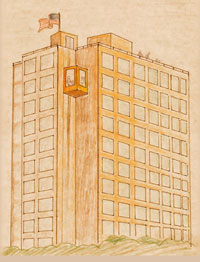|
Terrorists, Casinos, Creating Jobs Regrettably, the sorrowful events of September 11 have created yet another reason for the complete removal of the Moses parkway between Niagara Falls and Lewiston, New York. The elimination of vehicular traffic over the face of the power plant would increase security, significantly reducing the risk of explosives being transported by vehicle to ground zero of this generating facility. We know all too well the terrible devastation that can be produced by an explosive-packed truck or van. The Niagara Heritage Partnership does not rejoice in advancing this argument. We wish that the reason for mentioning it had never occurred, but it has, and we mention it rather than remain silent. This most recent tragedy has also negatively impacted travel worldwide, seriously compromising the tourism industry. It may be that the Niagara region can no longer rely on a bountiful influx of international or airborne visitors. The International Labor Organization estimates that related U.S. job cuts could be “as high as 3.8 million.” Empire State Development has similar concerns. No one can say how long this condition will last, or when, if ever, air travel will return to pre-crisis levels. Now more than ever a concentration on the domestic marketing of Niagara to the millions interested in heritage and ecotourism should be viewed as a new opportunity for maintaining or strengthening our tourism base. Since the Partnership has long presented this focus as the primary rationale for our gorge rim restoration proposal, we were pleased to hear this view echoed at the “Rethinking Niagara” symposium on 24 October. At this meeting, leaders from business, government, and the tourism industry had the opportunity to consider the benefits of heritage tourism, especially as it pertained to the market including Buffalo and Canada. Our proposal, with specific details and suggestions, concentrates on the U.S. side of the Niagara River gorge and the revitalization of a more depressed urban environment—and those interested in this information can find it at www.niagaraheritage.org, especially at “Comments made to Business Associations of Niagara Falls, 31 May 2000.” This increased interest in heritage tourism is being linked by some as a local response to offset nationally difficult times as money gets assigned elsewhere to protect us in a terrorist-altered economy. Even more clearly, state officials are citing the September 11 attack as the rationale for swift action on obtaining casino gambling for Niagara. Casinos are viewed as a new revenue source for the state, which Governor Pataki has estimated will lose $9 billion over the next 18 months as a result of the attack. While the Partnership believes that the gorge
restoration project should be pursued with or without casinos, and
recognizes pre-casino construction barriers yet exist, as do disputes
over revenue sharing, casinos may indeed provide a source of economic
benefit to the region: their construction and operation will provide
jobs; a percent of the money generated will be paid to host communities.
If a casino does become a reality for Niagara, many assume that
an enhanced investment climate will be created.
This climate should intensify the possibility of Moses parkway
removal, natural gorge rim restoration, and the completion of associated
projects necessary to realize the proposal’s full potential. Generally, first stage work would be as follows:
Additionally, the Partnership strongly advocates the following to realize the full potential of gorge rim restoration:
ARTIST: RICHARD PIZA
The improved security, job creation, strengthened tourism market via a heritage focus, and other business opportunities provided by gorge rim restoration can be accomplished with funding from a variety of sources. The $150 million in the Environmental Protection Fund, though currently threatened by the possibility of being tapped for general state use, is one such potential source; the $10 million matching funds from the National Park Service has promise; the Greater Buffalo Niagara Regional Transportation Council has $10 million set aside to help with such a proposal; private sector investment would apply in some instances; State Parks funding could be used for the completion of some aspects; other funds might be obtained from the USA Development Corp; perhaps a fraction of the host community casino share could be applied to Niagara Falls gorge sections—Senator Maziarz has spoken of the need for such funds to be targeted for economic development: neighborhood revitalization, job creation, and tourism, major components of the Niagara Heritage Partnership proposal. In any case, if the people of the Niagara Frontier work together as an extended community, this most remarkable achievement, this nearly self-sustaining restoration of the natural environment can be our enduring gift to future generations. Bob Baxter Conservation Chair 26 October 2001 |
